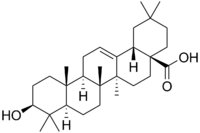Oleanolic acid
 |
|
| Names | |
|---|---|
|
IUPAC name
(4aS,6aR,6aS,6bR,8aR,10S,12aR,14bS)-10-hydroxy-2,2,6a,6b,9,9,12a-heptamethyl-1,3,4,5,6,6a,7,8,8a,10,11,12,13,14b-tetradecahydropicene-4a-carboxylic acid
|
|
| Other names
Oleanic acid
|
|
| Identifiers | |
|
508-02-1 |
|
| 3D model (Jmol) | Interactive image |
| ChEBI |
CHEBI:37659 |
| ChEMBL |
ChEMBL168 |
| ChemSpider |
10062 |
| ECHA InfoCard | 100.007.347 |
| EC Number | 208-081-6 |
| 3306 | |
| PubChem | 10494 |
|
|
|
|
| Properties | |
| C30H48O3 | |
| Molar mass | 456.71 g·mol−1 |
| Appearance | White |
| Melting point | > 300 °C (572 °F; 573 K) |
|
Except where otherwise noted, data are given for materials in their standard state (at 25 °C [77 °F], 100 kPa).
|
|
|
|
|
| Infobox references | |
Oleanolic acid or oleanic acid is a naturally occurring pentacyclic triterpenoid related to betulinic acid. It is widely distributed in food and plants where it exists as a free acid or as an aglycone of triterpenoid saponins.
Oleanolic acid can be found in olive oil, Phytolacca americana (American pokeweed), and Syzygium spp, garlic, etc. It was first studied and isolated from several plants, including Olea europaea (leaves, fruit), Rosa woodsii (leaves), Prosopis glandulosa (leaves and twigs), Phoradendron juniperinum (whole plant), Syzygium claviflorum (leaves), Hyptis capitata (whole plant), Mirabilis jalapa and Ternstroemia gymnanthera (aerial part). Other Syzygium species including java apple (Syzygium samarangense) and rose apples contain it.
Oleanolic acid is relatively non-toxic, hepatoprotective, and exhibits antitumor and antiviral properties.
Oleanolic acid was found to exhibit weak anti-HIV and weak anti-HCV activities in vitro, but more potent synthetic analogs are being investigated as potential drugs.
An extremely potent synthetic triterpenoid analog of oleanolic acid was found in 2005, that is a powerful inhibitor of cellular inflammatory processes. They work by the induction by IFN-γ of inducible nitric oxide synthase (iNOS) and of cyclooxygenase 2 in mouse macrophages. They are extremely potent inducers of the phase 2 response (e.g., elevation of NADH-quinone oxidoreductase and heme oxygenase 1), which is a major protector of cells against oxidative and electrophile stress.
...
Wikipedia
